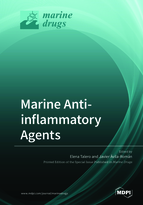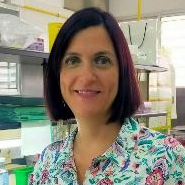Marine Anti-inflammatory Agents
A special issue of Marine Drugs (ISSN 1660-3397).
Deadline for manuscript submissions: closed (31 January 2019) | Viewed by 77886
Special Issue Editors
Interests: pharmacology; inflammation; cancer; colon; skin; polyphenols; carotenoids; microalgae; probiotics
Special Issues, Collections and Topics in MDPI journals
Interests: microalgae; Inflammation; oxylipins; Inflammatory Bowel Disease; colon cancer; inflammatory skin diseases
Special Issues, Collections and Topics in MDPI journals
Special Issue Information
Dear Colleagues,
Acute inflammation is a highly-regulated process, and its dysregulation can lead to the development of a chronic inflammatory state, which is believed to play a main role in the pathogenesis of many diseases, including cancer. The molecular mechanisms underlying chronic inflammation are beginning to be elucidated: Reactive oxygen species (ROS) stimulate intracellular signaling pathways and transcription factors, including MAPK and NF-kB. ROS can also activate a multiprotein complex called inflammasome, which regulates the activation of caspase-1 and subsequent maturation of pro-inflammatory cytokines (IL-1β and IL-18). The transcription factor Nrf2 plays a key role in the protection against oxidative stress in numerous inflammatory diseases since it regulates the transcription of antioxidant enzymes. Moreover, the participation of sirtuins, such as SIRT1 and SIRT6 and autophagy in this process is currently being studied.
In recent years, the need to find new anti-inflammatory molecules has raised the scientific community´s interest for marine natural products. In this regard, the marine environment represents an excellent source to isolate bioactive compounds from microbes, such as bacteria, cyanobacteria, fungi, algae or small invertebrates, such as sponges, tunicates, bryozoans and mollusks. This Special Issue of Marine Drugs will cover the entire scope of marine agents with anti-inflammatory activities, both in vitro and in vivo, as well as the latest status of clinical development from drug trials. In particular, works that evaluate molecular mechanisms of these compounds are especially encouraged.
Prof. Elena Talero
Dr. Javier Avila
Guest Editors
Manuscript Submission Information
Manuscripts should be submitted online at www.mdpi.com by registering and logging in to this website. Once you are registered, click here to go to the submission form. Manuscripts can be submitted until the deadline. All submissions that pass pre-check are peer-reviewed. Accepted papers will be published continuously in the journal (as soon as accepted) and will be listed together on the special issue website. Research articles, review articles as well as short communications are invited. For planned papers, a title and short abstract (about 100 words) can be sent to the Editorial Office for announcement on this website.
Submitted manuscripts should not have been published previously, nor be under consideration for publication elsewhere (except conference proceedings papers). All manuscripts are thoroughly refereed through a single-blind peer-review process. A guide for authors and other relevant information for submission of manuscripts is available on the Instructions for Authors page. Marine Drugs is an international peer-reviewed open access monthly journal published by MDPI.
Please visit the Instructions for Authors page before submitting a manuscript. The Article Processing Charge (APC) for publication in this open access journal is 2900 CHF (Swiss Francs). Submitted papers should be well formatted and use good English. Authors may use MDPI's English editing service prior to publication or during author revisions.
Keywords
- Marine compounds
- Antioxidant molecules
- Inflammation
- Immune response
- Sirtuins
- Autophagy
- Inflammasome
- Cytokines








